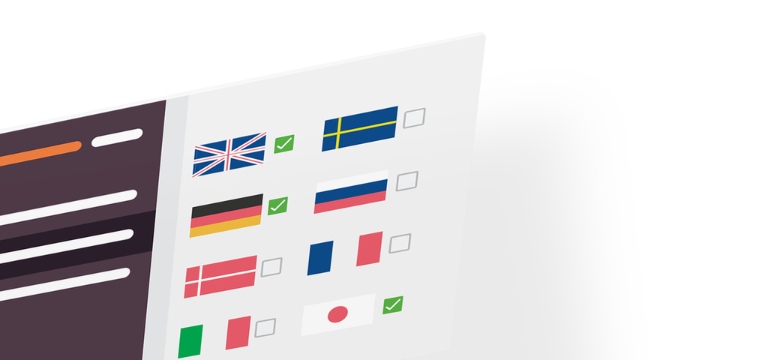
Verity Hartley
Marketing Specialist, LanguageWire
LinkedIn

Verity Hartley
Marketing Specialist, LanguageWire
LinkedIn

If you have ambitions to be a global brand, then you’ll need a website that speaks like a local.
Helping businesses reach their global audience is what LanguageWire is all about. Through LanguageWire, brands collaborate with translators, copywriters, proofreaders and DTP experts from around the globe. But what's the point of creating all this multilingual content if people can't find your website? That’s why we have created a useful checklist to help you make your content visible online.
If you have ambitions to be a global brand, then you’ll need a website that speaks like a local. It's no longer "enough" to launch a website in English and hope that visitors from around the world can figure it out themselves.
Language matters for your business! CSA Research found that 84% of business buyers are more likely to buy a product with online information in their own language. The same goes for B2C. A CSA Research survey of 3,000 Online Shoppers across 10 Countries found that 60% rarely or never buy from English-only websites.
International SEO makes it easy for people to find online content suited to their locale. To excel at International SEO, you'll need a mix of traditional SEO which will help improve your content’s visibility to search engines and high-quality translation. This powerful combination will bring more traffic to your website with adapted content to your target locales, ensure search engines can understand it, and most importantly satisfy visitors.
Start by getting the technical aspects right. It’s the foundation upon which you build your website. Your content won’t be in the top three search results with technical SEO alone, but without it, you won’t get near page one.

What is a ccTLD? A country code top-level domain.
You may not recognise the acronym, but the letters that follow the final stop mark in any URL are globally recognised. Choosing the right domain name is a crucial part of your international SEO strategy.
Your choice may depend on whether you are country targeting or language targeting. If you want to grow your brand in a new country, you should purchase your brand name ccTLD for that location. It may even be worth securing these ccTLDs now so that they are available for market expansion later.
If your international SEO strategy or budget does not stretch to managing several ccTLDs at once, you could focus on language targeting instead and use subdirectories on your existing domain.
The hreflang tag is one of the first html tags added to a page of code. It quickly allows Google and other web crawlers to identify what language the page content uses.
The ‘rel=alternate’ tag tells the search engine that this page is an alternate version of the canonical page, which helps avoid issues with duplication of content. The ‘hreflang’ tag then identifies the language of the page, including variants, and makes it more likely that the search engine will show the right content to the right audience.
The hreflang tag doesn’t work with some search engines like the Chinese Baidu or Bing, so you will need to implement a specific meta tag instead.
The first step of any major International SEO strategy or implementation must be to do your keyword research. Not only will this help to see which markets are already showing interest in your online content, but it will help you accurately target the right audience for your services.
So, how do you start to do international SEO keyword research?
Start with what you already have. Hopefully, you are already tracking keywords that help get your website ranked in the search engines in your primary language. These keywords are a great starting place, but they will likely not be the same ones you want to use in your target market.
Directly translating keywords is an error that many companies make when working in different languages. Keywords should never be translated; they need to be transcreated if you want your international SEO strategy to succeed.
You need to find and validate keywords in your target languages that match the keyword volume and search intents of your primary language customers. You will find that the Search Engine Results Pages (SERPs) vary enormously between countries and languages.

Once you have your localized keywords, you need to do the same with your content. Not all your content will work in different global markets. Some themes will resonate, whereas others fall flat with no cultural frame of reference.
We have talked a little already about the differences between translating and localizing content and shown how if you want to break into larger global markets, you need to be doing more than simply hitting translate on your content.
Images, voiceovers, ad copy, website articles and even uses of colours are elements that need to be considered from a local perspective. Not doing could result in a cultural backlash, so we consider it an essential step on our international SEO checklist.
Following up on the need for localization mentioned above, if you do translate your texts, you should not just rely on a machine translation. It may be tempting for just a little bit of ad copy to quickly get a translation via a machine translation tool, but the results could be more than you bargain for.
Post editing validation by a human native-speaking expert will ensure that no cultural blunders are part of your final copy. Validation takes proofreading a step further by giving you a native’s insight into the phrasing and words chosen.
Machine translation is a great place to start but needs to be supported by human expertise to make it market it ready.
Building a website can be a large task, and it is easy to get bogged down in the technical details. It is possible to get too focused on making a site work for Google and forget the humans interacting with the site at the other end.
Don’t forget to design your website for user experience as well as ranking well in the SERPs. When you find your new localized keywords, don’t be tempted to stuff them throughout your new copy. International SEO best practices follow the same rules as your primary language SEO.
Write for humans, not robots.
In the context of localization, designing for user experience will also mean looking at how the text reads in different directions and how it sits on the page once translated. You may find that your website design built for English speakers looks dreadful in German when the text needs twice as much pixel space to fit on the page.
Metadata content is often forgotten when building websites which is a critical mistake as it is a vital ranking factor for pages. Meta titles and descriptions appear in the SERPs, and we use them to pre-judge a website before we even click the link.
Google has strict rules about the length of meta content and will cut meta descriptions off mid-flow if they pass the 155-character sweet spot. Likewise, page titles on tabs and search results perform best when they are 60 characters long.
Once you have mastered the art of concise expression in your metadata, everything is reset back to zero when they are translated into another longer language. Many companies forget to optimise their metadata in other languages, thinking the translation will be enough. This allows their competitors to steal ranking from them by writing succinct, eye-catching copy in the target secondary language.
An excellent rule for any website is that the content needs to be engaging and insightful to keep your readers interested. This doesn’t change when you are writing in a different language. Experienced translators and transcreators can help with this by proofreading and editing the original content to make it more engaging to different global audiences.
Since 2019, EAT content has become a key ranking factor for websites on Google. EAT stands for Expertise, Authoritativeness and Trustworthiness, which are three goals you need to have in mind when writing for your site, especially if your site has an eCommerce element.
eCommerce sites are seen as YMYL content (Your Money or Your Life) which tend to rank a little lower than EAT sites. So, if you are selling to your new audience be sure to also provided them with expert content in your market area to help readdress the balance.

Another ranking factor Google considers important is website page speed. They look at a lot of on page factors to judge what kind of experience your web page provides your customers. Pages that take a long time to load are frustrating and can lead to users quitting a website out of frustration, leading to a poor-quality review by the search engine.
Your website response times can be affected by slow loading videos, graphics or large files. Page speed can also be compromised when you are hosting a website in one country for users who are in another. CDNs or content distribution networks can help share this load and bring your website resources closer to your customers. This in turn speeds up your site and keeps the search engines happy.
When you start adjusting your content for a different audience you also need to think about the other sources they may be used to reading. Your content will contain links to other websites and authoritative sources but if all these sources are located within your country and primary language, they are less likely to resonate with your customers.
Make sure as part of your global SEO strategy that you take the time to go through all your articles and note down any links that need to be updated to either a local source or a target language version of a page. Your customers will appreciate the effort and will be likely to stay on the site longer, boosting your rankings.
Global markets are already waiting for you to reach out to them, and there is no better time than now to start planning your international SEO strategy. Use our checklist to help you identify how your current website measures up against iSEO best practices.
If you are unsure on how to get started, try speaking with some international SEO experts. LanguageWire we have SEO experts who can optimise your content for your global audiences and help you extend your reach into new markets. Contact us now to talk about how we can help you build multilingual content that will expose you to new audiences and boost your traffic.
Would you prefer the checklist as a pdf? No problem! You can download the pdf for sharing, printing or use it as your new desktop background.
Find out more
How can we help you?
Your journey to a powerful, seamless language management experience starts here! Tell us about your needs and we will tailor the perfect solution to your enterprise.